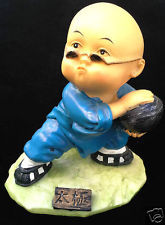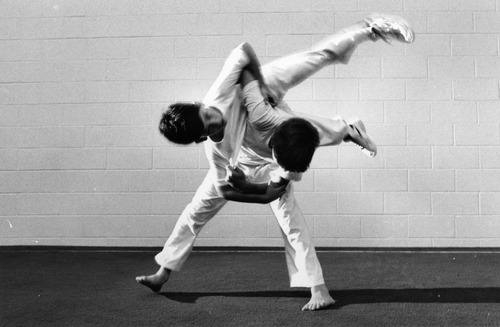
CHILDREN & THE MARTIAL ARTS—AN UPHILL BATTLE
By Christopher J. Goedecke
More than ever, our children need a serious and sensitive approach toward understanding violence, aggression and empowering self-disciplines. Never before have martial arts instructors found themselves in the vanguard to shape young minds in this regard. However, the general public still wonders what our children are actually exposed to in the American Dojo and how they are being taught. There is a wide diversity between teaching methods and philosophies in our nation’s martial art schools. This blog presents some of the issues and underlying debates about children and martial arts.
Martial Art Trends In The United States
From 1950 through the early 1960’s the majority of martial art students consisted primarily of male teenagers and adults approximately 17-35 years old. During the 1970’s this profile began shifting toward younger enrollees and an increasing female population. Of the nearly three million active martial artists in this country today, it is guesstimated that 80-85% are now children. Most schools in the 1960’s rarely enrolled children below the age of seven. Today it is common to find the bulk of a school’s classes filled with mostly four through eight year olds. One local school in my area takes them in at 1½!

How Young Can A Child Start Training?
There is no general agreement in the martial art community as to how young a child should be to effectively learn martial arts. No two children are the same. Some five year olds possess better attention spans and coordination then some eight year olds. However, there is very strong debate about whether young children can fully comprehend traditional or ‘authentic’ martial discipline. Effective teaching is also made more complex when the teaching methods are generalized for a wide range of age groups.
Most children, six years and younger, are not developmentally capable of grasping the essential psychological or moral concepts found in traditional martial arts study. They certainly enjoy and demonstrate the physical skills and they show interest in individual technique but the discipline and mental capacity for long term study, with the absorption of abstract concepts, generally applies only to the exceptional youth.
Notwithstanding, most martial instructors are also businesspeople and they have been adapting to the demands of the youth market. One emerging trend has been the introduction of ‘pre-karate’ classes to capture the very young. These programs present basic fitness routines by using simple martial games and sports activities based loosely around martial techniques and elementary self-defense awareness training.
No Two Schools Teach The Same
No two martial arts schools offer the same instruction. A teacher’s experience, teaching methods, philosophies, fees, ranking structure and requirements, and measures of excellence, vary widely. Perhaps, we have reached a time when it is no longer appropriate to use the black belt as a standard of expert level among different schools. A ranked child in one school may be vastly superior to a similarly ranked child in another. For this reason it is not fair or accurate to compare the progress of a child in school A to another in School B without understanding the teaching goals of both schools.
The endgame of martial arts study is not about earning belts and certainly not about earning them quickly. It is about developing self-discipline and practical skills. It takes a certain amount of time for an average person to acquire a specific degree of skill, confidence and understanding in anything including martial arts. The only way to accomplish a polished look in a shorter time frame is to train more frequently, which brings us to the unique problem of today’s young student.
Today’s Young Student
Martial instructors are observing a steady deterioration in the average attention spans of children coupled with an increase number of behaviorally challenged children per class, as well as an overall decline in physical coordination. Though there are always bright stars in the dojo, today’s student body desires an entertaining educational format, demonstrates a decreasing respect for knowledge from authorities (replaced instead with a growing self-reliance on ‘figuring it out for themselves’), a lack of team cooperation replaced by a strong individual ‘me’ attitude. These challenges add new depth to the word ‘discipline’ for instructors confronting children who only crave the icing on the cake.
Children generally have unrealistic expectations regarding their skill advancement. I cite the media for instilling the ideas that you can achieve superiority in a short time, without working for it and for cultivating the Nikeism spirit of ‘Just Do It,’ where no real thought goes into their performance, and only new experiences are sought for as a value in themselves. Anyone who has observed the tournament scene from thirty years ago to today can see a striking degradation of skills. We do not teach jump spinning back kicks in the first class, and we wouldn’t practice them five times before we went on to another technique. Some children don’t agree. They want new, now! If we look at their choices of entertainment, we find them identifying with ‘Mortal Combat-styled’ video games whose dramatic actions would be the extreme exception in real life choices of action.
Teaching is a cooperative effort. An attentive teacher needs a focused student to spark an effective exchange of knowledge. The use of incentives such as belts and other awards are only effective as motivational tools if given for a true and observable advancement or achievement. To simply promote a child whose parents meet monthly payments is a false award. To promote a child because he is pouting, or threatens to quit, is worse. To promote a child simply because he attends class but shows little personal interest in striving for better performance is not enough. Time in grade, though a factor in considering promotions, is never the sole determinate. There should be some recognizable, qualitative progress to merit any rank advancement.
What do martial art teachers look for or define as ‘recognizable progress’ in considering an award such as belt promotion?

Quality And Quantity
In most teaching organizations there are two distinct arenas in which a student is evaluated in regards to his/her advancement in rank. The first is obvious. A student must become proficient with a quantifiable amount of information. For beginners, it is often exposure to the basic techniques of their system. If ten different basic maneuvers are required for a yellow belt, a student who knows only four does not meet the requirement. The second is a subjective evaluation of the quality of the movements performed. Quality can be defined as ‘the degree of excellence’ of a student’s performance of his required techniques. If a white belt demonstrates a poor understanding of the mechanics of his basic strikes by executing them sloppy, slow, off balance or incorrectly, that student is not ready for advancement. An ideal state of learning balances quality and quantity of talent. We never sacrifice one merit for the other.
Also, just as there are various impediments to a student’s potential coming from within the student, no teacher is perfect either. Teaching requires clear communication skills and, at the very least, a basic understanding of how children of various developmental stages learn. If teachers are clear about their objectives, and if they use effective methods, their students will find a sure path to forge their skills.

Pacing
Two students who both attend the same classes may still not progress equally. The reason for this lies in the personal pacing of each student, which is influenced by the instructor’s choice of pacing for that student. At the intermediate level, instructors may dispense different quantities of information to a student after assessing that student’s self-motivation, attentiveness, home practice routine, and quality of the material currently practiced. Some sensei also seek to develop children’s values and virtues in addition to their physical technique. Patience is a particularly important benefit in today’s jet-propelled age. Correct pacing leads to realistic advancement. If a student refuses to follow the recommended pacing of his instructor he may either confront boredom or frustration, the death knell of study if it rings for to long. In a group class setting where there are no penalties/rewards for giving your best in the class, pacing can be the most difficult part of teaching.
Group Versus Private Training.
Most students participate in a group instruction. The pacing for group instruction is always geared for the advancement of the average student’s performance. Limitations of class size and instructor assistance cannot always address the slow or the gifted learner. Private training is a way to advance the slow and the gifted by customizing their training routines and dealing specifically with their learning level. Private instruction shores up the more extreme learning needs of the talented or slow students.
Three Golden Pearls
Martial arts teachers are not perfect beings. Although sensei’s strive for absolutes, there are going to be moments of frustration or miscommunication that teacher and student will have to work out. A teacher/student relationship is a delicate and dynamic one that needs all the care and sensitivity of any healthy relationship to thrive and benefit both parties. When a child enrolls in our classes we extend our best care. As future citizens we understand that they will carry within them the seeds of our influence. As martial art author, Thomas White, poetically describes in his book, Three Golden Pearls On A String;
“ A single thread strings together the three golden pearls of wisdom; each pearl a step on the path leading from man to master; each joined to the other by the all encompassing life force. They manifest one as the student, one as the instructor, and one as the instructions. “
